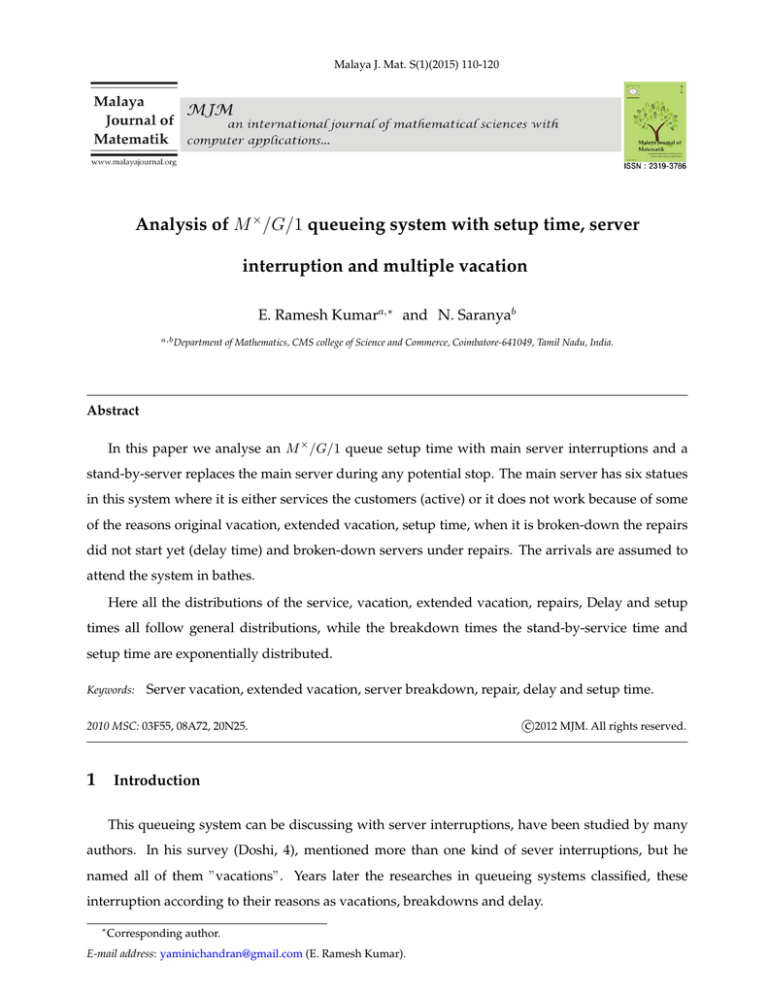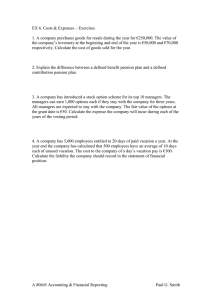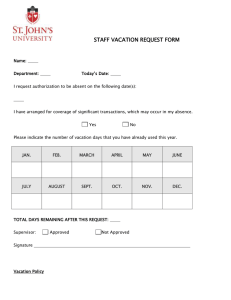Full Article PDF - Malaya Journal of Matematik
advertisement

Malaya J. Mat. S(1)(2015) 110-120 Analysis of M × /G/1 queueing system with setup time, server interruption and multiple vacation E. Ramesh Kumara,∗ and N. Saranyab a,b Department of Mathematics, CMS college of Science and Commerce, Coimbatore-641049, Tamil Nadu, India. Abstract In this paper we analyse an M × /G/1 queue setup time with main server interruptions and a stand-by-server replaces the main server during any potential stop. The main server has six statues in this system where it is either services the customers (active) or it does not work because of some of the reasons original vacation, extended vacation, setup time, when it is broken-down the repairs did not start yet (delay time) and broken-down servers under repairs. The arrivals are assumed to attend the system in bathes. Here all the distributions of the service, vacation, extended vacation, repairs, Delay and setup times all follow general distributions, while the breakdown times the stand-by-service time and setup time are exponentially distributed. Keywords: Server vacation, extended vacation, server breakdown, repair, delay and setup time. 2010 MSC: 03F55, 08A72, 20N25. 1 c 2012 MJM. All rights reserved. Introduction This queueing system can be discussing with server interruptions, have been studied by many authors. In his survey (Doshi, 4), mentioned more than one kind of sever interruptions, but he named all of them ”vacations”. Years later the researches in queueing systems classified, these interruption according to their reasons as vacations, breakdowns and delay. ∗ Corresponding author. E-mail address: yaminichandran@gmail.com (E. Ramesh Kumar). E. Ramesh Kumar et al. / A study on interval valued... 111 Some researchers studied queueing systems with server vacation. In their work, Choi and Kim [3] considered a two-phase queueing system with server vacations and Bernoulli feedback, where the server takes vacation if the system becomes empty at the moment of the completion of the second phase services. Madan and Abu Al-Rub [8] assumed that there is one server in the system, the server may have a single vacation policy with elective phase type server vacations. Arumuganathan and Jayakumar [2] assumed that the server may leave to have vacation whenever the number of waiting customers in the queue does not exceed certain number 0 N 0 . When the server returns from a vacation and if the queue length is still less than 0 N 0 he leaves for another vacation and so on. Several authors studies queueing systems with server breakdowns. We can cite Aissani and Artalejo [1], Wang. Cao and Li [2], Madan et al. [1] and Senthil and Arumuganathan [10]. Queueing systems with vacations and breakdowns, have been studied by other researchers e.g., Maraghi, Madan and Dowmam and M. Jain and A. Jain [5]. In recent years, Khalaf, Madan and Lucas [6] introduced two new kinds of server interruptions; the extended vacation and the delay time Khalaf et al.[7] studied the queueing system already developed by them in their previous work, but this time they assumed that the system equipped with a stand-by-server works when system major server is on vacation or under repairs. In the queueing system the server could be on vacation, extended vacation, setup time, if it is broken-down the repairs did not start yet (delay time) or it is broken-down under repairs. The main adventure of this paper work is that it is assumed that system equipped with a standby-server works with setup time during all the main server. We present a clear closed form of the most interested performing measures. [The mean number of customers in the system, the mean number of customers in the queue and the mean waiting time in the system]. It is considered that the customers arrive to the system in batches, the vacations are Bernoulli scheduled, it is optional that the server goes to extended vacations, all the distributions of the service, vacation, extended vacation, repair, delay and setup time are assumed to follow different general distributions while the breakdown times, setup times and stand-by-service times follows the two different exponential distributions. 2 Model Assumption In this paper the Queueing system M × /G/1 has been discussed. It is known that there is only one server in this system is called ”main server”, because there is a stand-by-server services the customer when the main server cannot provide service to the customer. We consider that the customers reach the system in groups of size i, i = 1, 2, 3, · · · The mean arrival rate of the groups is λ > 0. The first order probability that a group of i customers arrives at 112 E. Ramesh Kumar et al. / A study on interval valued... the system during a short interval of time (t, t + ∆t), is given by λci ∆t, where 0 ≤ ci ≤ 1, and ∞ X c1 = 1 i=1 The service provide to the groups according to their arrival order, where all the customers of the second arrival group and so on. The groups provided service one by one on a first comefirst served basis. In order the group customers provide the service randomly where all the customers in the first group should receive their service before the customers in the second group and so on. The server times of the main server follow a general (arbitrary) distribution function G(s) and density function g(s). Let µ(x) ∆x be the conditional probability of service completion during the g(x) interval (x, x + ∆x) given that µ(x) = and therefore 1 − G(x) Z s g(s) = µ(s)e − µ(x) dx 0 The main server may have some different interruptions. The first interruption is the original vacation. It is assumed that the vacation time is Bernoulli Scheduled, when the main server completes any service it many take vacation (with probability P) or continue providing service (with probability 1-P). The server vacation times are generally distributed with distribution function and density function B(v), b(v) respectively. Let β(x) ∆x denotes the conditional probability that the server completes a vacation provide during the interval (x, x + ∆x) given that the elapsed vacation time is x. b(x) So that β(x) = and, therefore, 1 − β(x) Z v b(v) = β(v)v − β(x) dx 0 The second potential stop of the main server is the extended vacation. On completion of a vacation period, the server has an option of taking an extended vacation. The server may take an extended vacation with probability γ(0 ≤ γ ≤ 1) or it may rejoin the system immediately after completion of the original vacation with probability 1 − γ. The extended vacation times are generally distributed, The distribution function of the extended vacation times is w(x). The density function of the extended vacation times is w(x). Let φ(x) ∆x denotes the conditional probability that the server completes extended vacation period during the interval (x, x + ∆x) given that the elapsed time of the extended vacation time is x, so that φ(x) = w(x)/ [1 − w(x)] and therefore Z w(x) = φ(x) exp − 0 x φ(t) dt E. Ramesh Kumar et al. / A study on interval valued... 113 The server may encounter random breakdowns, the breakdown times follow poisson distribution with mean breakdown rate > 0. Assume that when the server breaks down, the customer whose service is interrupted comes back to the head of the queue but it is instantly taken up for service by the stand-by-server. Once the system breakdown, the repairs do not start immediately and there is a delay time waiting for repairs to start with setup time. The delay times are generally distributed with delay distribution function and delay density function F (x), f (x) respectively. Let θ(x)∆x denotes the conditional probability that the server finishes a delay period during the interval (x, x + ∆x) given that the elapsed delay time is x, so that,θ(x) = f (x)/ [1 − F (x)] and therefore, x Z f (x) = φ(x) exp − θ(t) dt 0 When the server breakdown the repair process may start any time with setup time . The repair time are generally distributed with repairs distribution function and repairs density function H(x), h(x) respectively. Let γ(x)∆x denotes the conditional probability that the repairs of the server completed during the interval [x, x + ∆x] given that the elapsed repairs time is x. So that γ(x) = h(x)/(1 − H(x)) implies Z h(x) = γ(x) exp − x γ(t) dt 0 Let η(x)∆x denotes the conditional probability that the server, completes the repair time, prior, during the interval (x, x + ∆x) given that the elapsed setup time. So that η(x) = e(x)/(1 − E(x)) implies, Z e(x) = η(x) exp − x η(t) dt 0 When the main server is on vacation, extended vacation, waiting for repairs to start or under repair and setup time in all these different interruptions, there is a stand-by-server, servers the customers until the main server returns. The stand-by-service times are exponentially distributed with stand-by-service time 1/δ. When the main server rejoins the system after any interruption, the customer being served by the stand-by-server transferred to the main server to start a service over. All stochastic process involved in the system are independent of each other. 3 Notations and definition Let us consider the following definitions and notations: 114 E. Ramesh Kumar et al. / A study on interval valued... (i) Probability that at time t, there are n(n ≥ 0) customers in the queue excluding the customer in service and the elapsed service time of this customer is x is denoted by Pn (t, x). The probability that at time t, there are n(n ≥ 0) customers in the queue excluding the customer in service irrespective of the value of x is denoted by ∞ Z Pn = Pn (t, x) dx 0 (ii) Probability that at time t, there are n(n ≥ 0) customers in the queue and the server is on original vacation with elapsed original vacation time x is denoted by Vn (t, x). ∞ Z Vn = Vn (t, x) dx 0 denotes the probability that at time t, the number of customers in the queue is n(n ≥ 0) and the server is on vacation whatever the value of x. It is the probability generating function of the, queue size when the server is on vacation is given by, Vq (x, z) = ∞ X z n Vn (x), n=0 Vq (z) = ∞ X z n Vn n=0 (iii) Rn (t, x) denotes the probability that there are n(n ≥ 0) customers in the queue at the time t, while the server is on repair process with elapsed repair time x. Z ∞ Rn (t) = Rn (t, t) dx 0 Refers to probability that there are n(n ≥ 0) customers in the queue at time t, while the server is on repair process whatever the value of x is. The probability generating function of the queue size is when the server is under repair is given by Rq (x, z) = ∞ X z n Rn (x), n=0 Rq (z) = ∞ X z n Rn n=0 (iv) Q(t) is the probability at time t, there are no customers in the system and the server is idle but available in the system. lim Q(t) = Q t→∞ E. Ramesh Kumar et al. / A study on interval valued... 115 is the steady state probability corresponding to Q(t). (v) Dn (t, x) denotes the probability that there are n(n ≥ 0) customers waiting in the queue at time t, and the server does not serve because it is suffering from breakdown and waiting for repairs to start with and it is waiting for repairs to start with elapsed delay time x. Z ∞ Dn (t) = Dn (t, x) dx 0 refers to the probability that there are n(n ≥ 0) customers in the queue at time t, and the server is waiting for repairs to start whatever the value of x. The probability generating function of the queue size when the server is waiting for a repair to start (on delay) is given by ∞ X Dq (x, z) = z n Rn (x), n=0 Dq (z) = ∞ X z n Dn n=0 (vi) En (t, x) denotes the probability that at time t, there are n(n ≥ 0) customers waiting in the queue, and the server is on an extended vacation with elapsed extended vacation time x. (vii) The probability that at time t, there are n(n ≥ 0) customers waiting the queue while the server is on an extended vacation whatever the value of x is, Z ∞ En (t) = En (t, x) dx 0 The probability generating function of the queue size when the server is on an extended vacation is given by Eq (x, z) = ∞ X z n En (x), n=0 Eq (z) = ∞ X z n En n=0 (viii) Tn (t, x) denotes the probability, that the time t there are n(n ≥ 0). Z ∞ Tn (t) = Tn (t, x) dx 0 The probability generating function of the queue size, is given by in the setup time. Tq (x, z) = ∞ X z n Tn (x), n=0 Tq (z) = ∞ X n=0 z n Tn 116 E. Ramesh Kumar et al. / A study on interval valued... (ix) C(z) = ∞ X z n Cn is probability generating function of the batch arrival size. n=0 (x) An (x) = lim An (t, x) is the steady state probability corresponding to an An (t, x). t→∞ An (x) = lim An (t, x) is the steady state probability corresponding to an An (t) where, A = P , V , t→∞ D, E, R, T . 4 System Equations n−1 X ∂ Pn (x) = −(λ + µ(x) + α)Pn (x) + λ Ci Pn−i (x), n ≥ 1 ∂x −→ (1) i=1 ∂ P0 (x) = −(λ + µ(x) + α)P0 (x) ∂x −→ (2) n−1 X ∂ Vn (x) = −(λ + β(x) + δ)Vn (x) + λ Ci Vn−i (x) + δVn+1 (x), n ≥ 1 ∂x −→ (3) ∂ V0 (x) = −(λ + β(x) + δ)V0 (x) + δV1 (x) ∂x −→ (4) i=1 ∂ En (x) = +(λ + θ(x) + δ)En (x) ∂x n−1 X +λ Ci En−i (x) + δEn+1 (x), n ≥ 1 −→ (5) i=1 ∂ E0 (x) = −(λ + θ(x) + δ)E0 (x) + δE1 (x) ∂x ∂ Rn (x) = +(λ + γ(x) + δ)Rn (x) ∂x n−1 X +λ Ci Rn−i (x) + δRn+1 (x), n ≥ 1 −→ (6) −→ (7) i=1 ∂ R0 (x) = 0 ∂x −→ (8) ∂ Dn (x) = +(λ + φ(x) + δ)Dn (x) ∂x n−1 X +λ Ci Dn−i (x) + δRn+1 (x), n ≥ 1 −→ (9) i=1 ∂ D0 (x) = 0 ∂x −→ (10) ∂ Tn (x) = +(λ + η(x) + δ)Tn (x) ∂x n−1 X +λ Ci Tn−i (x) + δRn+1 (x), n ≥ 1 i=1 −→ (11) E. Ramesh Kumar et al. / A study on interval valued... ∂ T0 (x) = 0 ∂x −→ (12) Z ∞ R0 (x)γ(x)dx + (1 − P ) + P0 (x)µ(x)dx 0 0 Z ∞ Z ∞ +(1 − γ) V0 (x)β(x) dx + (1 − P ) + E0 (x)θ(x) dx 0 0 Z ∞ + T0 (x)η(x) dx Z 117 ∞ λQ = −→ (13) 0 The boundary condition will be used to solve the set of equation represent the system. Z ∞ Z ∞ Pn (0) = (1 − P ) Pn+1 (x)µ(x)dx + (1 − r) + Vn+1 (x)β(x)dx 0 0 Z ∞ Z ∞ + En+1 (x)θ(x) dx + Rn+1 (x)γ(x) dx 0 Z0 ∞ + Tn+1 (x)η(x) dx + λ Cn+1 Q, n ≥ 0 −→ (14) 0 ∞ Z Vn (0) = P Pn (x)µ(x) dx, n ≥ 0 −→ (15) Vn (x)β(x) dx, n ≥ 0 −→ (16) 0 ∞ Z En (0) = γ 0 ∞ Z Dn (x)φ(x) dx, n ≥ 0 Rn (0) = −→ (17) 0 ∞ Z Pn−1 (x) = α Pn−1 , n ≥ 1 Dn (0) = α −→ (18) 0 D0 (0) = 0 Z Tn (0) = α −→ (19) ∞ Pn+1 dx 0 = α Pn+1 , n ≥ 1 −→ (20) T0 (0) = 0 5 Queue size distribution at a Random Epoch The main aim in this section is to find the probability generating function (PGF) of the queue size at a random epoch. Let Sq (z) denote the PGF of the queue size irrespective of the state of the system.Let Sq (z) denote the PGF of the queue size irrespective of the state of the system. Thus, Sq (z) = Pq (z) + Vq (z) + Eq (z) + Dq (z) + Rq (z) + Tq (z) 118 E. Ramesh Kumar et al. / A study on interval valued... To get Pq (z), Vq (z), Eq (z), Dq (z), Rq (z) and Tq (z) the method used in (Khalaf et.al., [6]). To get, Pq (z) = −Qm [1 − G∗ (a)] a [z − G∗ (a)(1 − P + P B ∗ (ω)k)] − αzJ −→ (21) Vq (z) = −a Qm P G∗ (a)(1 − B ∗ (ω)) ωa [z − G∗ (a)(1 − P + P B ∗ (ω)k)] − αωJ −→ (22) Eq (z) = −a QmγP G∗ (a)B ∗ (ω)(1 − w∗ (ω)) aω [z − G∗ (a)(1 − P + P B ∗ (ω)k)] − αzωJ −→ (23) Dq (z) = −Qmαz(1 − G∗ (a))(1 − F ∗ (ω)) aω [z − G∗ (a)(1 − P + P B ∗ (ω)k)] − αzωJ −→ (24) Tq (z) = −a QmP (1 − G∗ (a))(1 − T ∗ (ω)) aω [z − G∗ (a)(1 − P + P B ∗ (ω)k)] − αzωJ −→ (25) Where a = λ − λC(z) + w = λ − λC(z) + λ − λ/z J = [1 − G∗ (a)] F ∗ (ω)H ∗ (ω) m = λ − λC(z) k = 1 − γ + γ w∗ (ω) G∗ (a), B ∗ (a), W ∗ (a), F ∗ (a), H ∗ (a), are the Laplace Stieltjes transform of the service time G(x). Vacation time B(x), extended vacation time W (x), delay time F (x) and repairs time H(x) setup time T (x) respectively. Adding all the equations from (21) to (25). Sq (z) = −Qm[1 − G∗ (a)] [w + γz(1 − F ∗ (ω)H ∗ (ω))E ∗ (ω) aP G∗ (a)(1 − B ∗ (ω))(1 − T ∗ (ω))] a ω(z − G∗ (a)(1 − P + P B ∗ (ω)) − αzωJ −→ (26) To find Q, we use the normalization condition Sq (1) + Q = 1 0 The value of Sq (1) is indeterminate, So we apply L Hospital0 s rule two time in (26). To find the steady state avg queue length Lq , the known relation d Lq = Sq (z) could be used. We can derive the mean waiting time in the queue by using littles dz z=1 law Wq = Lq /λ 6 Particular cases The queueing system discussed in this work can be considered as a general system. Here we will 119 E. Ramesh Kumar et al. / A study on interval valued... discuss the case as following, 6.1. No Vacation, No Extended Vacation, stand by server and No Breakdown: (No delay, No Repairs) If we assume there is no vacation, no extended vacation, no stand by server and no breakdown, (no delay, no repairs), This means that P = 0, W ∗ (w) = 1, γ = 0, δ = 0, α = 0, F ∗ (w) = 1 and T ∗ (w) = 1 respectively. From equation (26), we get, Sq (z) = −Q(1 − G∗ (a)) z − G∗ (a) Sq (z) = Qm(G∗ (a) − 1) z − G∗ (a) This result agree with the known results of M /G/1. 7 Conclusion In this paper the behaviour of multiple vacation in M /G/1 model with setup, server interruption are analysed. The probability generating function of queue size at arbitrary time epoch and different completion epoch are obtained. References [1] Aissani, A., & Artalejo, J.R. (1998), On the single server retrial queue subject to breakdowns, Queueing Systems, 30(3-4), 309–321. [2] Arumuganathan, R., & Jeyakumar, S. (2005), Steady state analysis of a bulk queue with multiple vacations, setup times with policy and closedown times, Applied Mathematical Modelling, 29, 927–986. [3] Choi, D., & Kim, T. (2003), Analysis of a two phase queueing system with vacations and Bernoulli feedback, Stochastic Analysis and Applications, 21(5), 1009–1019. [4] Doshi, B.T. (1986), Queueing systems with vacations-a survey, Queueing system, 1, 29–66. [5] Jain, M., & Jain, A. (2010), Working vacation queueing model with multiple types of server breakdowns, Applied Mathematical Modelling, 34, 1–13. [6] Khalaf, R. F., Madan, K.C., & Lucas, C.A (2011b), An M /G/1 Queue with Bernoulli Schedule General Vacation Times, General Extended Vacations, Random Breakdowns, General Delay Times for repairs to Start and General Repair Times, Journal of Mathematics Research, 3(4), 8–20. 120 E. Ramesh Kumar et al. / A study on interval valued... [7] Khalaf, R. F. (2012). On Some Queueing Systems with Server Vacations, Extended Vacations, Breakdowns, Delayed Repairs and Stand-bys. (A PhD theses submitted to School of Information Systems, Computing and Mathematics, Brunel University.) [8] Madan, K. C., & Abu Al-Rub, A. Z. (2004). On a single server queue with optional phase type server vacations based on exhaustive deterministic service and a single vacation policy. Applied Mathematics and Computation, 149, 723–734. [9] Retab F. Khalaf (2013) Queueing Systems with four different main Server0 s Interruptions and a Stand Server. [10] Senthil, M., & Arumuganathan, R, (2010). An M /G/1 retrial queue with two phase service subject to active server breakdowns and two types of repair, International Journal of Operational Research, 8(3), 261–291. Received: May 08, 2015; Accepted: June 19, 2015 UNIVERSITY PRESS Website: http://www.malayajournal.org/



